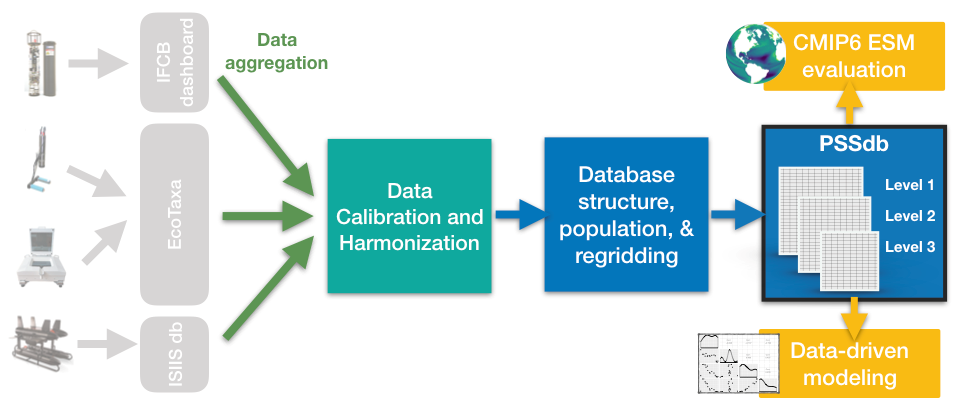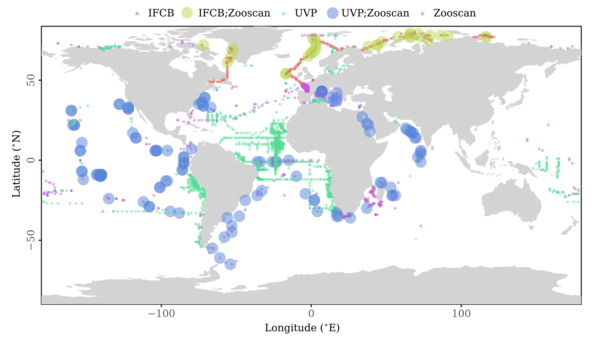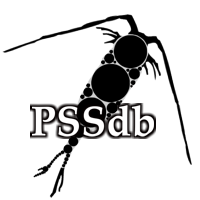Pelagic Size Structure
from plankton imaging systems
Plankton ("ocean drifters", https://planktonchronicles.org/) are a diverse group of microscopic and small organisms that form the base of marine food webs, and thus provide food to fish and marine mammals of cultural and economic importance.
Marine plankton include phytoplankton (bacteria such as Prochlorococcus and algae such as diatoms, capable of using the sun's energy to produce food i.e. photosynthesis), mixotrophs (organisms capable of both photosynthesis and feeding on other organisms, such as dinoflagellates), and zooplankton (microscopic and small animals, such as copepods and jellyfish).
The key biological activities of these animals such as growth, reproduction, food acquisition and death, are considered pathways by which energy and nutrients are moved through marine food webs.
The way plankton shapes marine food webs and influences the cycling of nutrients is determined by their traits, such as body shapes, motility, and food acquisition strategies.

Examples of plankton and detritus pictures obtained by imaging systems.
Imaging systems allow to accurately determine the size of most planktonic organisms, from small phytoplankton to large jellyfish, fishes and shrimp.
It also allows to determine the size of non-living particles (detritus, dashed squares).
Image sources: Imaging Flow Cytobot (IFCB): Massicotte et al. (2020) and https://ifcb-data.whoi.edu/timeline?instruments=10. Underwater Vision Profiler (UVP) and Zooscan: R. Kiko. ISIIS images: Luo (2015)
|
To characterize the plankton community, scientists are often using organism size as a "master trait".
Size influences many key processes of plankton biology, such as CO2 and nutrient uptake, growth, and predation.
The relative abundance of different plankton size classes, referred to as the community size structure, can then be used to estimate relevant ecosystem properties such as total biomass (the amount of living things in an ecosystem) and the efficiency of biomass transfer up to different food web levels.
However, measuring the size of microscopic plankton for millions of individuals is difficult to achieve with traditional approaches.
Quantitative imaging of plankton provides a fast, reliable way to obtain size measurements of thousands of individuals in any given sample.
Plankton imaging systems, which can range from small tabletop camera systems, to large multi-instrument imaging vehicles, have been under development within the scientific community for several decades, and have proliferated in recent years.
In parallel, significant advances have been made to increase the capacity to store and access large imaging datasets, resulting in more wide-spread adoption across oceanographic laboratories.

|
Plankton imaging systems that provide data to PSSdb.
These systems range from tabletop scanners to in-situ imaging vehicles deployed on large oceanographic research ships.
IFCB = Imaging FlowCytoBot, UVP5 = Underwater Vision Profiler 5, ISIIS = In-situ Ichthyoplankton Imaging System.
|
Plankton imaging systems also allow scientists to identify specific organisms of interest and train automated plankton image classification models, to tease apart plankton from non-living particles in the ocean's water.
Non-living particles can include dead cells and animals, feces, molts, mucus, and sadly, microplastics.
The size of these particles controls the rate of processes relevant to carbon cycling, such as the conversion rate of organic carbon (i.e. carbon in dead organisms) to mineral carbon (Carbon dioxide).
In addition, larger, more compact particles tend to sink faster than small, loose particles.
Particle sinking transports organic carbon to deeper parts of the ocean, and ultimately reach the bottom sediments.
This organic Carbon is considered to be 'trapped' and cannot liberate carbon dioxide back to the atmosphere.
This process is referred to as the 'biological carbon pump', which is one of the main processes by which the world's oceans regulate atmospheric temperatures and CO2.
Knowing the global size distribution of these particles can help us accurately predict how much atmospheric carbon dioxide the oceans are sinking to the bottom.

|
Project schematic. Data will be aggregated from a range of imaging systems (Imaging FlowCytoBot, Underwater Vision Profiler, ZooScan, and the In-situ Ichthyoplankton Imaging System), which will then be subject to cross-calibration and harmonization.
The harmonized data will then populate the PSSdb, an open-access database with three data levels.
We will use PSSdb to conduct Earth System Model (ESM) evaluation and data-driven modeling.
|

|
Current coverage of the datasets included in PSSdb.
Datasets collected by a series of Imaging FlowCytoBot (red circles), Underwater Vision Profiler (cyan circles), ZooScan (pink circles), and joint instruments (large circles), will provide information of plankton broad size structure on a global scale.
(Generated on October 18, 2022)
|
Fri Nov 15 10:26:40 AM EST 2024
|


